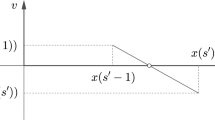Abstract.
Let \( q\colon \Bbb Z^n\to \Bbb Z \) be an integral quadratic form of the shape¶¶\( q(x)=\sum\limits\limits ^n_{i=1}q_ix^2_i+\sum\limits\limits _{i\le j}q_{ij}x_ix_j \)¶¶with \( q_i\le 1 \), for every \( 1\le i\le n \). Several procedures have been introduced to study these forms. In this paper we consider the edge reduction procedure introduced in [7]. ¶A form \( q\colon \Bbb Z^n\to \Bbb Z \) is weakly non-negative if \( q(x)\ge 0 \) for every vector x with non-negative coordinates. Let \( q^\prime \colon \Bbb Z^{n+1}\to \Bbb Z \) be obtained from q by edge reduction, then q is weakly non-negative if and only if so is \( q^\prime \). We propose an algorithm to decide if q is weakly non-negative.
Similar content being viewed by others
Author information
Authors and Affiliations
Additional information
Received: 19.11.1996
Rights and permissions
About this article
Cite this article
von Höhne, H., de la Peña, J. Edge reduction for weakly non-negative quadratic forms. Arch. Math. 70, 270–277 (1998). https://doi.org/10.1007/s000130050195
Published:
Issue Date:
DOI: https://doi.org/10.1007/s000130050195




